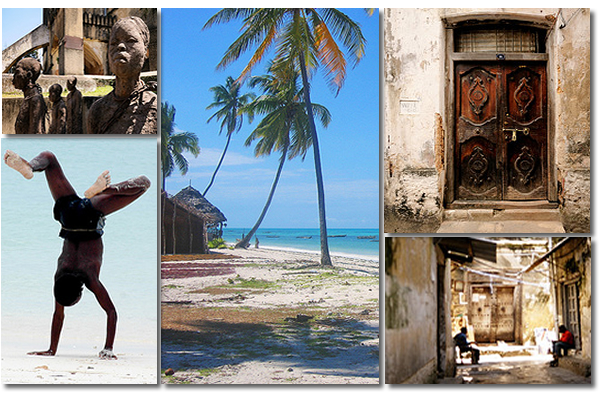Zanzibar Island Tanzania
It is here that an entirely different aspect to Tanzania, and east Africa in general, is revealed. Since time immemorial the east African trade winds have carried maritime traders backwards and forwards between India and the Arabian Peninsula, and the long east coast of Africa. The most obvious manifestation of this sustained influence in Trade & Islam is the ubiquitous sail dhow, which is nowadays an iconic feature of the east coast from the Red Sea to the Archipelago Islands of Mozambique.

The central focus of Islamic East Africa has always been Zanzibar Island. This was the latter day seat of the Sultans of Oman, and for centuries the main entrépot for the vast inland reach of the Indian Ocean Slave Trade. Trade has in fact been the lifeblood of Zanzibar since the earliest days of settlement. Its ideal location adjacent to the mainland made it a perfect base for any number of Arab and colonial forays inland. It remained under the control of the Oman Sultanate deep into the colonial period, and only merged politically with the mainland in the early 1960s.
David Livingstone referred to the Zanzibar island of the mid-19th century as ÂstinkibarÂ. This was thanks to the almost total lack of sanitation at that time, a thriving fishing and fish selling industry, and of course the fact that Zanzibar has long been one of the worldÂs most prolific producers of cloves. Nowadays, although still not the cleanest urban centre in the world, Zanzibar is a great deal more fragrant, with the aroma of cloves and nutmeg mixed less with effluent than clean salt breezes.
The main feature of Zanzibar is Stone Town. This is the historic quarter, and refers to the Arabic/Swahili practice of building in coral, which differed at the time greatly from the standard materials used in home and civic construction. Typical scenes of Zanzibar are narrow streets with atmospheric shops and stalls, and arched architraves with heavy doors carved in a manner distinctive to Zanzibar, and reminiscent of Swahili architecture up the length of the East African coast.
There is, of course, nowadays a strong modern strain to Zanzibar, but something about the island clings to its medieval heyday. The cultural flavor is distinctly Moorish, but also unmistakably African. Zanzibar is a small island, with a variety of beaches that conform to the quintessence of a tropical ocean paradise, and nothing is particularly far from anything else.
At the top end of the accommodation scale are a handful of very high end resort establishments, but much more atmospheric and authentic are the many small hotels, lodges and guesthouses scattered all over the island, with self catering complexes and beach side cabanas also available to the early birds.
All in All Zanzibar is the perfect way to enjoy a deep cultural massage after the hard sweat of a Kilimanjaro climb or a dusty safari through the vast interior. Zanzibar is a dive Mecca, a seafood and spice lovers heaven and a culture junkies nirvana.
How to get there
There are several daily flights offered from Dar es Salaam and Kilimanjaro to Zanzibar. Direct flights also serve Zanzibar International Airport from Johannesburg, Mombassa, Nairobi, Entebbe, Addis Ababa, and further afield from Madrid, Milan, Zurich.
It is also very easy to cross from the mainland by boat or ferry. The main operators are Azam Marine, Fast Ferries, Sea Star, Seagull and Sepideh Megaspeed Liners. Fares range from US$40 Â US$50. The trip lasts about two hours and is an excursion unto itself. It is possible to take a day trip from Dar es Salaam allowing plenty of time to see the main sights.
Although Zanzibar is part of Tanzania it has its own immigration service so make sure you have your passport.
Watch out for touts and faux guides who will hassle you for tips or to help you find a good ferry. You will never come out on the receiving end if you engage one of these, so forceful avoidance is the key.
